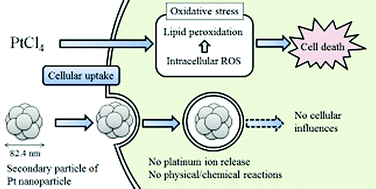Evaluation of cellular influences of platinum nanoparticles by stable medium dispersion†
Abstract

- This article is part of the themed collection: Metal Toxicity
* Corresponding authors
a
Institute of Industrial Ecological Sciences, University of Occupational and Environmental Health, Japan, Kitakyushu, Fukuoka 807-8555, Japan
E-mail:
masa-horie@med.uoeh-u-ac.jp
Fax: +81 93-691-7466
Tel: +81 93-691-4284
b Health Research Institute, National Institute of Advanced Industrial Science and Technology (AIST), 1-8-31 Midorigaoka, Ikeda, Osaka, Japan
c National Metrology Institute of Japan (NMIJ), AIST, Tsukuba, Ibaraki, Japan
d Research Institute for Environmental Management Technology (EMTECH), AIST, Tsukuba, Ibaraki 305-8569, Japan
e Research Institute of Science for Safety and Sustainability (RISS), AIST, Tsukuba, Ibaraki, Japan
f Faculty of Applied Biological Sciences, Gifu University, Gifu, Japan

 Please wait while we load your content...
Something went wrong. Try again?
Please wait while we load your content...
Something went wrong. Try again?
 Fetching data from CrossRef.
Fetching data from CrossRef.
This may take some time to load.
Loading related content
